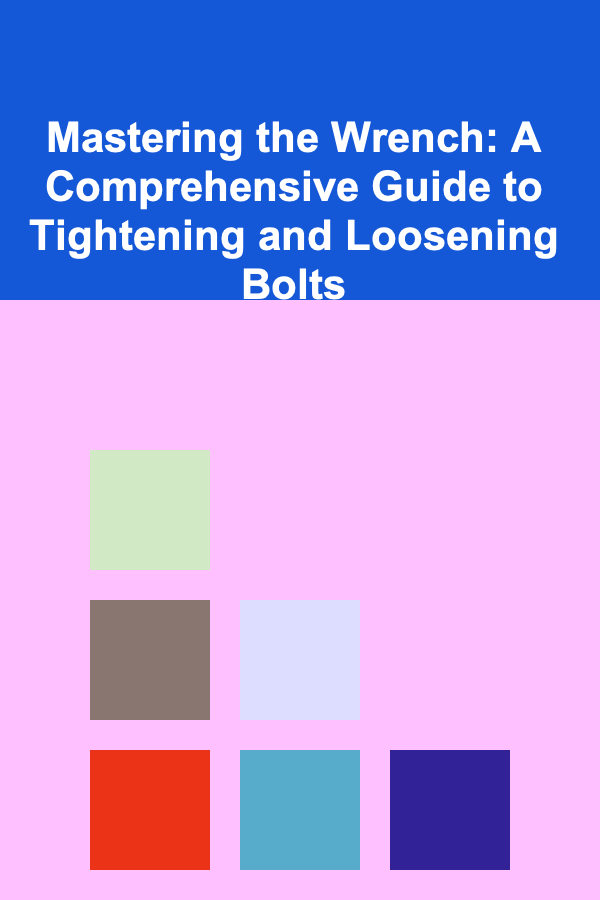
Mastering the Wrench: A Comprehensive Guide to Tightening and Loosening Bolts
ebook include PDF & Audio bundle (Micro Guide)
$12.99$6.99
Limited Time Offer! Order within the next:

The wrench, in its various forms, is arguably one of the most fundamental tools in any toolbox, from the hobbyist's garage to the professional mechanic's shop. Its primary function -- tightening and loosening bolts and nuts -- is ubiquitous across countless applications. While the principle seems straightforward, using a wrench effectively and safely requires understanding different types of wrenches, selecting the right size, applying the correct technique, and understanding the potential pitfalls. This comprehensive guide will delve into the intricacies of using a wrench set, providing you with the knowledge and skills to tackle any bolting task with confidence.
Understanding the Wrench Landscape: Types and Applications
Before attempting any task involving bolts and nuts, it's crucial to understand the diverse range of wrenches available. Each type is designed for specific applications and boasts unique advantages. Using the wrong wrench can lead to damaged bolts, injury, and frustration. Here's an overview of the most common wrench types you'll find in a typical wrench set:
Open-End Wrenches
Open-end wrenches feature a U-shaped opening that grips two opposing faces of a bolt or nut. They are simple, versatile, and ideal for situations where access is limited. However, they offer a less secure grip than other types, increasing the risk of slipping and rounding the bolt head. They are often sold as double-ended wrenches, with a different size opening on each end, maximizing versatility in a single tool.
Pros:
- Good for tight spaces.
- Quick to use.
- Inexpensive.
Cons:
- Prone to slipping.
- Can easily round off bolt heads.
- Less torque application compared to other types.
Box-End Wrenches
Box-end wrenches have a closed loop that fully encircles the bolt head or nut. This provides a much more secure grip than an open-end wrench, reducing the risk of slipping and damage. The closed design allows for greater torque application and is better suited for stubborn or corroded fasteners. Many box-end wrenches are offset, providing clearance to work around obstructions.
Pros:
- Superior grip.
- Reduces the risk of rounding.
- Allows for greater torque.
Cons:
- Requires more clearance around the fastener.
- Slower to use than open-end wrenches.
Combination Wrenches
Combination wrenches offer the best of both worlds, featuring an open-end on one side and a box-end on the other. This allows you to quickly switch between tasks depending on the situation. They are a staple in any wrench set, providing a balance of speed and security.
Pros:
- Versatile.
- Combines the advantages of both open-end and box-end wrenches.
- Cost-effective.
Cons:
- Inherits the limitations of both open-end and box-end wrenches.
Ratcheting Wrenches
Ratcheting wrenches are box-end wrenches that incorporate a ratcheting mechanism. This allows you to tighten or loosen a bolt without having to remove the wrench and reposition it after each turn. This saves significant time and effort, especially in tight spaces. The ratcheting mechanism allows for quick and efficient work, but it's essential to ensure the mechanism is strong enough for the required torque.
Pros:
- Extremely fast and efficient.
- Ideal for repetitive tasks.
- Reduces the need for repositioning.
Cons:
- Can be more expensive.
- Ratcheting mechanism can fail under high torque.
- Often bulkier than standard box-end wrenches.
Adjustable Wrenches (Crescent Wrenches)
Adjustable wrenches, also known as Crescent wrenches, feature an adjustable jaw that can be sized to fit a variety of bolt and nut sizes. While convenient, they are not ideal for heavy-duty applications due to the potential for slipping and rounding. They are best used for occasional tasks or when the exact size wrench is unavailable. They are versatile but should be used with caution.
Pros:
- Adjustable to fit different sizes.
- Convenient for occasional use.
Cons:
- Prone to slipping.
- Can easily damage fasteners.
- Not suitable for high-torque applications.
Pipe Wrenches
Pipe wrenches are designed specifically for gripping and turning pipes. They have serrated jaws that dig into the pipe surface, providing a secure grip. They are not intended for use on bolts or nuts, as they will damage the fastener heads.
Pros:
- Excellent grip on pipes.
- Durable and long-lasting.
Cons:
- Will damage bolts and nuts.
- Not suitable for general-purpose wrenching.
Socket Wrenches
Socket wrenches, used in conjunction with sockets and a ratchet, are exceptionally versatile. Sockets, available in various sizes and shapes (e.g., 6-point, 12-point, deep well), attach to the ratchet, providing a secure grip and allowing for efficient tightening and loosening. Socket wrenches are particularly useful in confined spaces where a full swing of a standard wrench is not possible.
Pros:
- Very versatile due to the variety of sockets.
- Strong and durable.
- Excellent for tight spaces.
Cons:
- Requires a separate ratchet and sockets.
- Can be bulky.
Selecting the Right Wrench: Size Matters
Choosing the correct wrench size is paramount for both safety and effectiveness. Using a wrench that is too large or too small can lead to slipping, rounding the bolt head, and potential injury. Wrenches are typically sized in either metric (millimeters) or SAE (inches). It is crucial to use the correct system for the fastener you are working on. Trying to use a metric wrench on an SAE bolt (or vice-versa) is almost guaranteed to damage the fastener.
Metric vs. SAE
The distinction between metric and SAE (Society of Automotive Engineers) sizes is critical. Metric measurements are based on the decimal system (millimeters), while SAE measurements are based on fractions of an inch. Visually, the difference can be subtle, but using the wrong system can quickly lead to damage. Always check the markings on the bolt or nut, or consult a parts diagram, to determine the correct size.
Identifying the Correct Size
The size of a wrench is typically stamped or etched onto the wrench itself, usually near the head. Ensure the markings are clear and legible. If you're unsure of the size, start with a wrench that appears close and test it on the fastener. If it's too loose, try a smaller size. If it doesn't fit, try a larger size. The wrench should fit snugly on the bolt head or nut without excessive play. Using adjustable wrenches as a "catch-all" should be avoided if possible, as they are more prone to slipping.
The Art of Tightening: Achieving the Right Torque
Tightening a bolt or nut is more than just turning the wrench until it's "tight enough." Over-tightening can damage the fastener or the components being joined, while under-tightening can lead to loosening and failure. Understanding torque and how to achieve the correct torque is essential for many applications.
Understanding Torque
Torque is a measure of rotational force, often expressed in foot-pounds (ft-lbs) or Newton-meters (Nm). It represents the amount of force applied at a distance from the axis of rotation. The required torque for a particular bolt or nut depends on its size, material, and application. Manufacturers typically specify torque values for critical fasteners in service manuals or repair guides.
Using a Torque Wrench
A torque wrench is a specialized wrench designed to measure and apply a specific amount of torque. There are several types of torque wrenches, including:
- Click-Type Torque Wrenches: These wrenches are pre-set to a specific torque value. When the desired torque is reached, the wrench will "click," providing an audible and tactile signal.
- Beam-Type Torque Wrenches: These wrenches feature a beam that deflects under load. A scale on the beam indicates the amount of torque being applied.
- Digital Torque Wrenches: These wrenches provide a digital display of the torque being applied, often with audible and visual alerts when the target torque is reached.
Using a torque wrench is crucial for ensuring that fasteners are tightened to the correct specification, preventing both over-tightening and under-tightening. Refer to the manufacturer's instructions for proper use and calibration of your torque wrench.
Tightening Techniques
- Clean the Threads: Before tightening, ensure the threads of the bolt and nut are clean and free of debris. A wire brush can be used to remove any rust or dirt.
- Lubricate the Threads (If Required): Some applications require the threads to be lubricated with a specific type of lubricant. Refer to the manufacturer's instructions.
- Position the Wrench: Ensure the wrench is properly seated on the bolt head or nut. The wrench should be perpendicular to the fastener.
- Apply Smooth, Controlled Force: Apply force smoothly and evenly, avoiding jerky or sudden movements.
- Tighten to the Specified Torque: If using a torque wrench, tighten the fastener until the wrench clicks (click-type) or reaches the specified torque on the scale (beam-type or digital).
- Follow a Tightening Pattern (For Multiple Bolts): When tightening multiple bolts in a pattern (e.g., cylinder head bolts), follow the specified tightening sequence. This ensures even distribution of force and prevents distortion. Typically, this involves tightening bolts in a criss-cross or spiral pattern, often in multiple stages.
The Art of Loosening: Conquering Stubborn Bolts
Loosening a tightly secured or corroded bolt can be a challenging task. Applying excessive force or using the wrong technique can damage the fastener or even break the wrench. Here are some strategies for tackling stubborn bolts:
Penetrating Oil
Penetrating oil is your best friend when dealing with stubborn bolts. Apply a generous amount of penetrating oil to the threads of the bolt and let it soak for several minutes, or even hours. The oil will seep into the threads, breaking down rust and corrosion, making it easier to loosen the bolt.
Heat
Applying heat to the bolt head can also help to loosen it. Heat expands the metal, breaking the bond between the bolt and the nut or threaded hole. A propane torch or heat gun can be used to apply heat, but be careful not to overheat the bolt, as this can weaken it. Exercise caution when using heat around flammable materials.
Impact Wrenches
An impact wrench is a power tool that delivers short, powerful bursts of torque. This can be very effective for loosening stubborn bolts without damaging them. Impact wrenches are available in both pneumatic (air-powered) and electric versions.
Breaker Bars
A breaker bar is a long, strong bar that provides extra leverage. It is used in conjunction with a socket wrench to apply greater force to the bolt. Be careful not to apply excessive force, as this can break the bolt.
Tapping the Bolt Head
Gently tapping the bolt head with a hammer can help to break the bond between the bolt and the nut or threaded hole. Use a brass or rubber mallet to avoid damaging the bolt head.
Using a Bolt Extractor
If the bolt head is rounded or damaged, a bolt extractor may be necessary. Bolt extractors are designed to grip the damaged bolt head and allow you to turn it. There are various types of bolt extractors available, including spiral extractors and fluted extractors.
Left-Handed Drill Bits
In extreme cases, if the bolt is broken off or severely damaged, a left-handed drill bit can be used to drill into the bolt. The rotation of the drill bit may be enough to unscrew the bolt fragment.
Preventing Future Problems
To prevent future problems with stuck bolts, consider the following:
- Use Anti-Seize Compound: Apply a thin layer of anti-seize compound to the threads of bolts, especially in environments prone to corrosion.
- Tighten to the Correct Torque: Over-tightening can damage the threads and make it more difficult to loosen the bolt later.
- Regular Maintenance: Inspect bolts regularly for signs of corrosion and address any issues promptly.
Safety First: Protecting Yourself and Your Equipment
Working with wrenches involves inherent risks. Following safety precautions is essential to prevent injuries and damage to equipment.
Eye Protection
Always wear safety glasses or goggles to protect your eyes from flying debris. Metal fragments, rust, and other particles can be dislodged when working with wrenches.
Hand Protection
Wear gloves to protect your hands from cuts, abrasions, and chemicals. Gloves also provide a better grip on the wrench.
Proper Footwear
Wear sturdy shoes with good traction to prevent slips and falls.
Work Area Safety
Keep your work area clean and well-lit. Remove any obstacles that could cause you to trip or fall.
Wrench Inspection
Inspect your wrenches before each use for signs of damage, such as cracks, bends, or worn jaws. Discard any damaged wrenches.
Proper Leverage
Use your body weight to apply force to the wrench. Avoid using excessive force, as this can cause the wrench to slip or break.
Avoid Extensions
Avoid using pipes or other extensions to increase the leverage of a wrench. This can overload the wrench and cause it to break, potentially leading to injury.
Direction of Force
Pull on the wrench rather than push. This reduces the risk of losing your balance and injuring yourself.
Electrical Safety
When working near electrical components, ensure the power is turned off and that the area is properly grounded. Use insulated wrenches to prevent electrical shock.
Conclusion: Mastering the Fundamentals
Using a wrench set effectively is a fundamental skill that requires understanding different wrench types, selecting the right size, applying proper tightening and loosening techniques, and prioritizing safety. By mastering these fundamentals, you can tackle a wide range of bolting tasks with confidence and precision. Remember to always choose the right tool for the job, prioritize safety, and never underestimate the importance of proper technique. With practice and attention to detail, you'll be well on your way to becoming a wrenching expert.

Blueprints of Success: Essential Skills and Knowledge for Maintenance Technicians
Read More
How to Create a Fun DIY Craft Station for Your Party
Read More
How to Stage Your Home's Entry Door for Curb Appeal
Read More
The Patent Attorney's Guide: Navigating the Complexities of Intellectual Property
Read More
How to Use Case Studies for Social Proof
Read More
10 Tips for Camping in Extreme Heat
Read MoreOther Products

Blueprints of Success: Essential Skills and Knowledge for Maintenance Technicians
Read More
How to Create a Fun DIY Craft Station for Your Party
Read More
How to Stage Your Home's Entry Door for Curb Appeal
Read More
The Patent Attorney's Guide: Navigating the Complexities of Intellectual Property
Read More
How to Use Case Studies for Social Proof
Read More